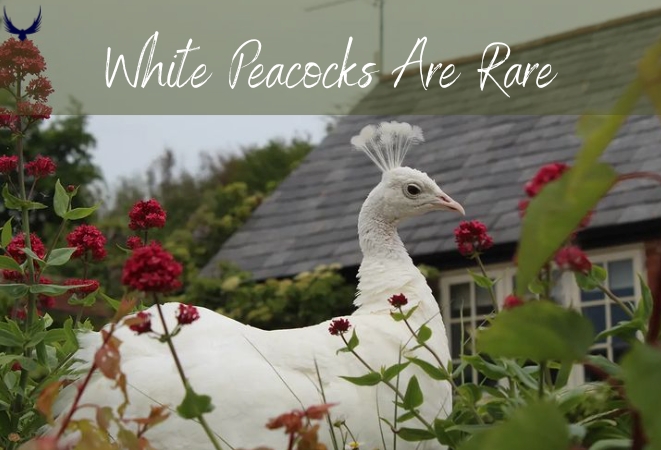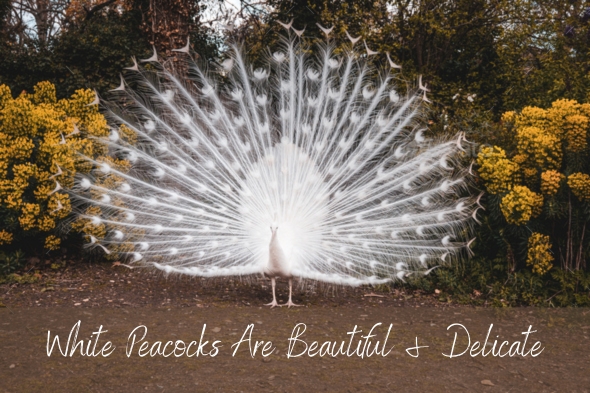White Peacocks are rare and beautiful birds that stand out among other colorful peacocks. They have pure white feathers that capture attention. White peacocks are often seen as symbols of purity and spirituality in different cultures.
But the main questions are how common are these birds and how do they get their striking colors? Let’s explore everything about the white peacocks to uncover these mysteries.
Fast Facts About White Peacocks
- White peafowl have a genetic mutation called leucism that makes their feathers white.
- White peacocks are sometimes called Albino Peacock, but true albinism is rare in peafowl.
- White peacocks are born yellow and become white as they grow up.
- White peacocks are very rare.
- White peafowl are rarely found in the wild and are mostly kept in captivity. If they were in the wild, their color would make it hard for them to survive.
- Male peacocks have a harder time attracting female peahens if they lack colorful feathers.

What is a White Peacock?
White Peacocks are a special type of Indian Blue Peafowl. They have a genetic mutation called leucism, which changes the color of their feathers but not their eyes or beak.
History of White Peacock
The British Empire brought white peafowl to Europe and America, when the British took over India. Some people think white peacocks might have been in India before the British came, but the first known white peacock bird one was seen in 1830.
Since then, people have been breeding white peafowl on purpose for their special white feathers.
Variety of White Color Patterns Peacock
Peafowl bred in captivity have different white color patterns.
- Pied White Peacock: mixture of white and the usual Indian blue colors
- Blackshoulder Pied White Peacock: normal coloration with white under parts, wings, and a spot under the chin
- Blackshoulder Peahen: which is white sprinkled with black spots.
Why Do Peacocks Have White Feathers?
White peacocks are not true albino peacocks. White peacocks have a special genetic mutation called leucism. This mutation changes the color of white peacock feathers. Most white peafowl have regular skin color. Unlike albino peacocks, white peacocks do not have red eyes or very pale skin.
Are Albino Peacocks Affected by Lack of Colors?
In the wild, white peacocks have difficulty attracting mates because they lack bright colors that catch the eye of potential partners. Colorful displays are crucial for getting attention during courtship and mating.

Compared to colorful peacocks, white peacocks find less opportunities to reproduce in nature. In captivity, where breeding can be controlled, a white peacock can be placed in good locations to increase its chances of mating and having offspring.
Are White Peacocks Rare?
White peacocks are quite rare in the wild since they have a genetic mutation called leucism that causes their feathers to lack pigment. This mutation occurs in only about 1 in 100 peacocks.
These stunning birds are more commonly found in captivity, where breeders specifically raise them for their unique appearance. Many zoos and private collectors keep white peacocks, making them less rare in these settings than in nature.
How Rare is a White Peacock?
White peacocks are rare in the wild, with only one in every 30,000. Experts believe they do not exist in the wild, but there is no evidence to prove this. People have started breeding for their unique color, which makes them more common in captivity.
What Does a White Peacock Symbolize?
White represents purity, so white peacock symbolism is linked to purity of mind and spirit. The white peacock symbolizes Jesus Christ in Christianity, nirvana in Buddhism. Luck and prosperity in Hinduism
These birds represent rebirth, resurrection, and the Holy Spirit. They also symbolize positive and clean energy, encouraging us to remove toxic influences and surround ourselves with positive people.
What Does a White Peacock Look Like?
The white peacock bird has blue eyes and white feathers with a slight discoloration of ocelli. There is a slight color change on its tail, making it unique. Male and female white peacocks look similar until they are 12 months old. As they grow, they become more distinct and show elegance and grace.
How Long do White Peacocks Live?
White peacocks are beautiful but delicate birds. The white peacock lifespan is about 20 years in the wild. They don’t live as long as other peacocks because they are more likely to get sick. This might be because of breeding for their white color, which can cause health issues.

White peacocks are often bred on purpose and kept in captivity. They can live up to 50 years.
What Does a White Peacock Eat?
All Peacocks are omnivores, so they eat both plants and meat. White peacocks are mainly herbivores. They mostly eat plants and insects, but they also eat a little meat if it is available. Peacocks eat insects, reptiles, amphibians, and rodents. They may be allergic to certain foods, get sick easily, or have other issues.
How Much Does a White Peacock Cost?
White peafowls can cost between $50 and $150 for a young one. An adult white peafowl costs between $200 and $500 or more, depending on factors like location, age, and availability.
Where do White Peacocks Live?
White peacocks are not as common as colorful ones. These peacocks live in places like India, Sri Lanka, and Pakistan. You can see them in the wild, sitting on trees or walking in gardens. Some white peacocks are kept in zoos and private collections.
White peacocks like warm places such as tropical forests. They prefer rivers or creeks to live nearby. Living near rivers or creeks also gives them water to drink and a cool place to escape the heat.
What do White Baby Peacocks Look Like?
Baby white peacocks, also called peachicks, are covered in fluffy white down feathers when they hatch, looking like small cotton balls with legs. They are smaller than regular colored peachicks but have the same body shape.
Unlike regular peacock babies that have brown or cream-colored feathers with stripes, white peachicks maintain their pure white coloring from birth. Their eyes are usually reddish or pink due to their leucistic condition.
Baby White Peacocks slowly develop their adult feathers as they grow,, which remain white but become more structured and eventually form the characteristic peacock tail pattern, though still completely white in color.
FAQs – White Peacocks
What are White Peacocks Called?
White peacocks are also known as Albino peacocks, Leucistic peacocks, or White peafowl.
What is the Rarest Peacock Color?
The white peafowls are rare. White peacocks are Indian Blue Peafowls with a rare genetic mutation called leucism.
How Many White Peacocks are there in the World?
The exact number of white peacocks in the world is not known since they exist both in the wild and in captivity. However, experts estimate there are several thousand white peacocks worldwide, with most of them being found in zoos and bird sanctuaries rather than in nature, where they’re extremely rare due to their genetic condition making them more vulnerable to predators.

